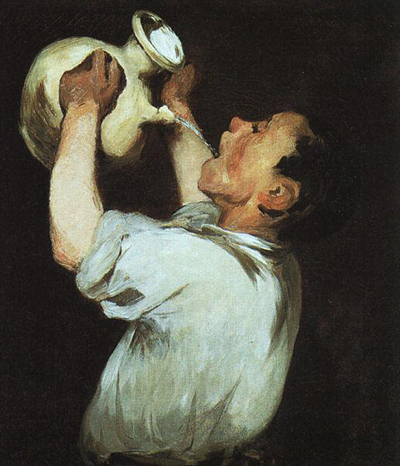The French artist, Edouard Manet, was born on the 23rd January 1832. He achieved little critical acclaim during his lifetime but is now regarded as a major influence in the development of Impressionist painting, and modern art.
While many artists, of the time, were painting historical and mythological figures, Manet concentrated on real life subjects. Beggars, Gypsies, and people sitting in cafes were all frequently featured in his work. A typical example of his art is, Boy with a Pitcher, an oil painting depicting a gypsy boy, holding a pitcher of wine, and drinking from it. The young lad is not drinking directly from the pitcher, instead, he holds it away from his mouth, and drinks without it touching his lips.
The painting is typical of Manet's work during this time; not overly detailed, and painted with loose brush strokes. The use of light and shade is characteristic of his style, and it is used to good effect in this picture. Especially noteworthy is the way the wine appears to shine, in the light, as it is poured from the jug. It was not uncommon for Manet if dissatisfied with a painting, to cut it into sections, in the process, creating new, smaller pieces of work. One of his most famous works The Dead Toreador was formed in this way. This is also the case with Boy with a Pitcher, which was originally part of a much larger canvas.
This earlier picture was titled Les Gitanes, a portrait of a family of gypsies, which Manet exhibited in 1863 and 1867. It appears, however, that he was unhappy with the work and he subsequently separated it into three individual paintings. Boy with a Pitcher, was one of three new portraits, and was extensively reconceived. The background was repainted in a dark brown, as opposed to the blue sky in the original, and a female gypsy, who appeared in Les Gitanes, was painted out completely. In addition, the figure of the boy was changed considerably.




